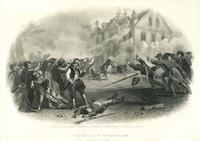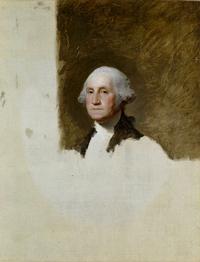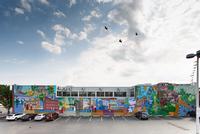In our ongoing series of historical posts about Philadelphia neighborhoods, today we bring you our neighbors to the northwest, Germantown...
Germantown was the first permanent German settlement in America.
Thirteen families from the town of Crefeld in the lower Rhine Valley arrived on October 6, 1683 and were greeted by William Penn and Francis Pastorius, who had arrived earlier and arranged the location of the land grant for the Germans. The settlers spent the first winter living in caves along the Delaware River while they cleared their land in Germantown. In 1987, Congress officially designated October 6 as German-American Day.
-
Germantown was the first permanent Mennonite settlement in America as well.
In the beginning, the Mennonites and Quakers worshipped together in each other’s homes, but as the community grew the families began worshipping separately. In 1708, the Germantown Mennonite Church was built. The church is now an historic site but the congregation continues to worship at a new location in Germantown. It is the oldest Mennonite congregation in North America.
-
Germantown was once the site of the U.S. government.
During November of 1793, President Washington rented a house in Germantown to escape the yellow fever epidemic in the city. He met there with his cabinet, including Thomas Jefferson and Alexander Hamilton, to conduct government business and debate foreign policy. This same house had been occupied by the British General William Howe during the Revolutionary War. Known as the Deshler-Morris House, it is owned by the National Park Service and is open to visitors on Saturdays during the summer.
-
Germantown is the birthplace of the anti-slavery movement in the U.S. and the site of the nation’s first written anti-slavery protest by white men.
On April 16, 1688, Francis Pastorius and three fellow Quakers drafted a petition to abolish slavery and presented it to the Society of Friends in Germantown. "There is a saying that we shall do to all men like as we will be done ourselves; making no difference of what generation, descent or color they are. And those who steal or rob men, and those who buy or purchase them, are they not all alike?..” The society did not act on this petition, but the ideas gradually gained acceptance in the Quaker communities of Pennsylvania as they advocated for the abolition of slavery throughout the 1700’s. In 1780, the Pennsylvania legislature established gradual emancipation of all slaves in the state, becoming the first free state in the nation.
-
 Germantown was the site of a Revolutionary War battle that helped bring the French into the fight.
Germantown was the site of a Revolutionary War battle that helped bring the French into the fight.
Emboldened by the success of his surprise attack on the British in Trenton on Christmas Day, 1776, Washington hoped to repeat his success with another surprise attack on the British forces quartered in Germantown in October of 1777. Troops were to approach the town from four directions under cover of night and attack at dawn. But the inexperienced troops got confused in the heavy fog, bypassing some British quarters and firing on Americans by mistake. Even so, the French were impressed with Washington’s plan and became his allies several months later.
-
The first kidnapping in the United States happened in Germantown.
 On July 1, 1874, Charley and Walter Ross were taken from the front yard of their family home in Germantown. Walter, age 6, was found in Philadelphia two days later and returned to his family, but Charley, age 4, was not found. A few days later Charley’s father received a ransom letter demanding $20,000 (about $400,000 in today’s dollars). Police advised the parents not to pay the ransom and the mayor’s office offered a $20,000 reward for information. An estimated 500,000 people searched for the boy over the next 5 months and in August Philadelphia police systematically searched every building in the city. Police zeroed in on two suspects who were shot in December during an attempted robbery. One suspect confessed to the kidnapping, but died before giving any information about the boy. Charley’s parents spent the rest of their lives and all their money searching for him, but to no avail. When the ransom notes came up for auction in November, 2013, they sold for $20,000.
On July 1, 1874, Charley and Walter Ross were taken from the front yard of their family home in Germantown. Walter, age 6, was found in Philadelphia two days later and returned to his family, but Charley, age 4, was not found. A few days later Charley’s father received a ransom letter demanding $20,000 (about $400,000 in today’s dollars). Police advised the parents not to pay the ransom and the mayor’s office offered a $20,000 reward for information. An estimated 500,000 people searched for the boy over the next 5 months and in August Philadelphia police systematically searched every building in the city. Police zeroed in on two suspects who were shot in December during an attempted robbery. One suspect confessed to the kidnapping, but died before giving any information about the boy. Charley’s parents spent the rest of their lives and all their money searching for him, but to no avail. When the ransom notes came up for auction in November, 2013, they sold for $20,000.
-
William Rittenhouse and his son, Nicholas, built the first paper mill in the U.S. in Germantown in 1690.
The original mill was destroyed by flood in 1701 but was replaced and produced paper for nearly two centuries. The mill was part of the fabric of Germantown’s prosperity. Germantown farmers grew flax and Germantown weavers turned it into fabric to be made into clothing and other goods. When the goods were worn out the rags were brought back to the mill to be made into paper. The Rittenhouse mill provided paper for Ben Franklin and other printers as well as cartridges and wadding for the rifles used to fight the Revolution.
-
The Wyck Rose Garden in Germantown is the oldest rose garden in America still using its original plan.
The garden was created in the 1820s and has over 80 historic roses, many of which were lost to the world except for the plants growing at Wyck. The oldest roses in the garden are varieties going back to the Crusades and the War of the Roses, planted here in the 1700’s.
-
Germantown was once the capital of American cricket.
Brought here by English immigrants working in the mills, the game of cricket was popularized in Germantown. The Germantown Cricket Club was founded in 1854 and in 1890 hired Stanford White’s firm to design its clubhouse, now a National Historic landmark. (White was later shot by Henry K. Thaw in what was called the "Crime of the Century.") For a while, thousands took the train out to Germantown to watch the cricket matches. But Americans preferred to watch faster paced games like football and baseball and the club was forced to reshape itself as a lawn tennis venue. Bill Tilden, the best tennis player of the 20th century, trained there and Theodore Roosevelt often played there with a group of advisors known as his "tennis cabinet." Cricket is still played in Philadelphia on several fields in Fairmount Park.
-
The first official U.S. Tennis Championship for women was held at Germantown Cricket Club in 1889.
Ellen Hansell was the first U.S. women’s singles champion.
-
 Gilbert Stuart painted the most famous portrait of George Washington in his studio in Germantown.
Gilbert Stuart painted the most famous portrait of George Washington in his studio in Germantown.
Although Gilbert painted over 100 portraits of Washington, it is this unfinished portrait that is the most famous and serves as the likeness on the $1 bill. Gilbert painted it along with a portrait of Martha Washington at her request. She wanted a pair of portraits to hang at Mount Vernon. But Gilbert never completed these portraits. Having captured what he felt was a perfect likeness of the president he kept it to use as a reference for the many Washington portraits he painted for sale to others. These portraits are currently on view at the National Portrait Gallery in Washington, DC.
Free Library resources:
- Images of Germantown in our Digital Collections
- Germantown in the Civil War by Eugene Stackhouse
- Germantown by Mary Jansen Parrent
- Remembering Germantown by Irvin Miller and Judith Callard
Have a question for Free Library staff? Please submit it to our Ask a Librarian page and receive a response within two business days.

